Tanks with a trailer
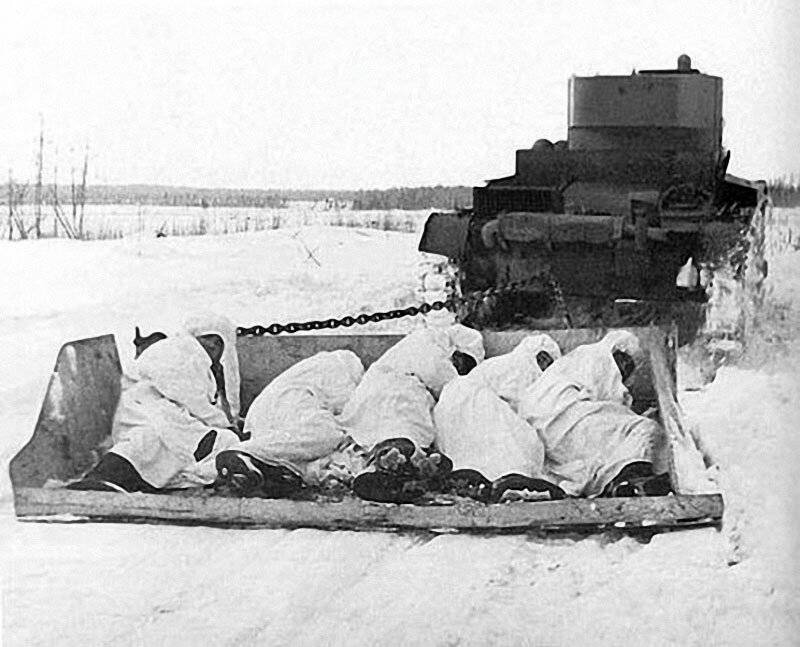
The most famous photographtank with a trailer, perhaps this one: the Soviet T-26 in the Finnish war tows an armored drag with fighters
Mom drives two trailers.
S. Mikhalkov "What do you have?"
Tank freak show. Somehow, for a very long time we did not go to our “tank freak show”, and there are still a lot of interesting things there. In particular, having got there (if it existed in reality, in the manner of a tank museum), we could see a whole alley of tanks, which should have been viewed not from the front, but from behind. Because it was on the back of them that the most interesting thing would be, namely, tank trailers that actually existed, were used, but about which very little is known.

Tank T-26 with self-made armored vehicles
The appearance of trailers is primarily associated with the Soviet-Finnish conflict. A very serious problem then turned out to be the escort of attacking tanks by infantry. It was very difficult for infantrymen to run through deep snow, and often it was simply impossible. Even when skiing, the infantrymen quickly lagged behind the tanks, that is, it made no sense to send tanks with infantry in these conditions.

T-26 with transport trailer
The solution to the problem was the massive use of armored sleds designed by Sokolov. First of all, they were calculated to be transported after the tanks of the assault units. At first they were successful. But then the Finns thought of letting tanks with such sleds deep into the defense and shooting them from the rear, where there was no armor. Nevertheless, quite a lot of them were made - 300 pieces. Moreover, the idea of an armored trailer continued to excite the minds of Soviet inventors during the Great Patriotic War. For 1941–1945 The department of inventions of the GABTU of the Red Army received more than two thousand proposals on this topic, but all of them were rejected due to the inappropriate use.

T-26 with MZP infantry transporter

T-34 with armored vehicles from T-60 hulls
However, already during the counter-offensive near Moscow, our army faced the same problem as during the war on the Karelian Isthmus. Because of the deep snow, the infantry quickly broke away from the tanks, and they lost their support.
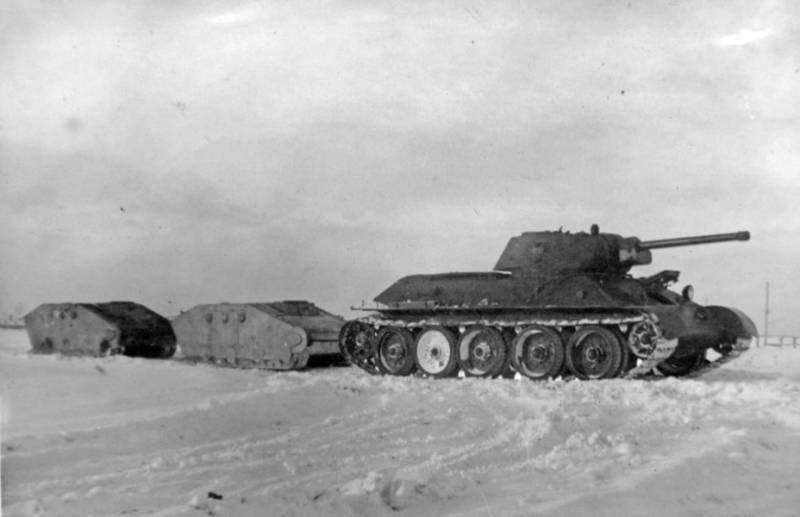
T-34 with armored vehicles from T-60 hulls. Photos of the war years
From the very beginning, they came up with the idea of carrying drags with high-explosive flamethrowers installed on them, which were installed on them up to 34 pieces, behind the T-20 tanks. The tank brought them closer to the enemy and ... A shower of fire fell on the enemy from the drag, something similar to our "Sunshine", only on a different principle of operation. But then they decided that infantry could also be carried on them. They began to make them from 6–8 mm steel, and to carry two such sleds at once behind the tank.
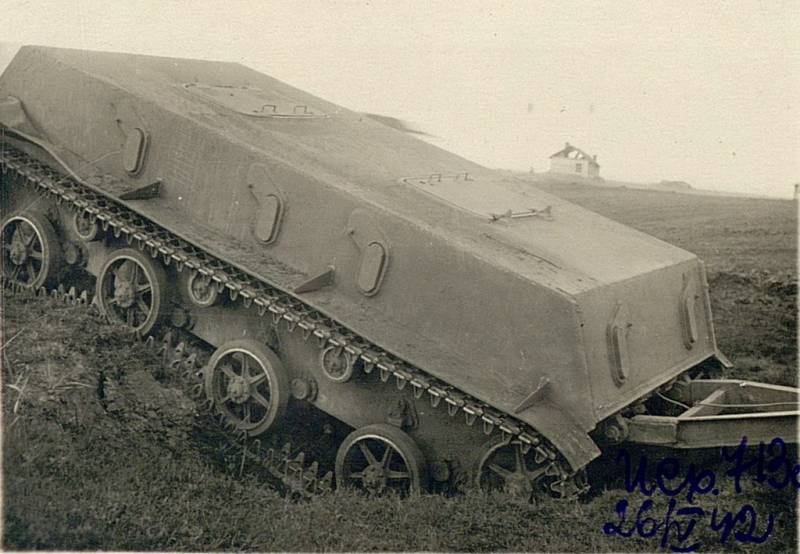
In the photo, the TD-200 infantry tracked transporter during testing
But the easiest way out was to use armored hulls from T-60 tanks, which were also towed two by two behind the T-34. Immediately, specialists from the Mytishchi Machine-Building Plant, who in December 1941 received an order from the People's Commissariat for Armaments to develop armored vehicles, also joined in the creation of armored sledges. And by the end of January 1942, they managed not only to develop them, but also to produce two truly monstrous samples under the B-65 index.
They were designed to carry 50 people, had a length of 6 m and anti-shell armor. That's just their weight was 20 tons, and so quite a working design. And even with double hatches on the sides and rear for landing. It is clear that such "sledges" were not accepted into service, just like the project to use T-34 hulls without a turret for transporting T-34 tanks behind tanks. In summer, the “transporter” moved behind the towing vehicle on tracks, and in winter they were removed, and it had to be transported on skids.
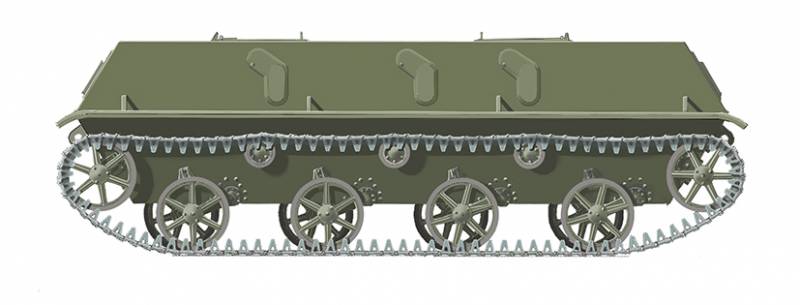
Figure TD-200
A more reasonable design turned out to be the "sleigh" BP-60, weighing 4 tons, from the hull of the T-60 tank. Three loopholes were arranged along the sides for firing from a personal weapons. At the back is a double door. Transported landing - 10 people. In total, they were released somewhere around 300 copies and sent to different sectors of the front as early as 1943.

KV-1E towing TD-200 during testing
Meanwhile, in February 1942, the project was no longer a sleigh, but a TD-200 tracked transporter on the chassis of the T-50 tank. It was sent by D. I. Chizhikov, deputy chief metallurgist of plant No. 78, in a letter addressed to Stalin. And since he had great opportunities, the car was built at the factory and began to be tested.
In fact, the TD-200 was a real tracked armored personnel carrier, only without an engine. The car had 10 loopholes for firing around the entire perimeter: 3 from the sides, 2 in front and 2 at the stern. All of them had armored flaps. Hatches were used for landing, and one was provided even in the bottom of the hull.

T-34-76 with BOT trailer
In total, three TD-200 machines were manufactured. They were tested, and in general the tests were successful. But the cost of all three of these armored trailers turned out to be equal to 126 rubles, that is, each vehicle cost 000. This price seemed to the GABTU not quite adequate, since the T-42 tank did not cost much more than this trailer, but it was still a tank, towed machine without engine.

The Germans had the same problems in winter and exactly the same solutions: Pzkfwg III FAMO with armored vehicles
Other models of sleds for transporting troops were also tested, and here it turned out that when driving through the snow and even along country roads, the tank and sled raise a cloud of snow dust, which makes firing from them impossible. So the idea "hung in the air." It seems that such machines were needed, but at the same time there were significant difficulties in their use, in addition to everything, their price was depressing, which is simply incomparable with their combat capabilities.

CV-35 "Ansaldo" in the flamethrower version
In other countries, they also dealt with tank trailers. So, flamethrower tanks were equipped with armored trailers as needed. For the first time, the Italian CV-35 Ansaldo flamethrower wedges were used during the war in Ethiopia in 1935. And then the Italians a year later sent them to Spain to help the rebellious Franco.

The Germans hitched similar fuel trailers to the Czechoslovak LT-38 tanks
But the French army was even armed with special 37L armored transporters with a trailer and without weapons, which served specifically for the transport of ammunition and equipment. They began to enter the army into service with tank units from the end of 1939. But after 1940, almost all of them fell into the hands of the Germans, who began to use them in a variety of ways. And some were even turned into self-propelled guns and vehicles for launching rockets.
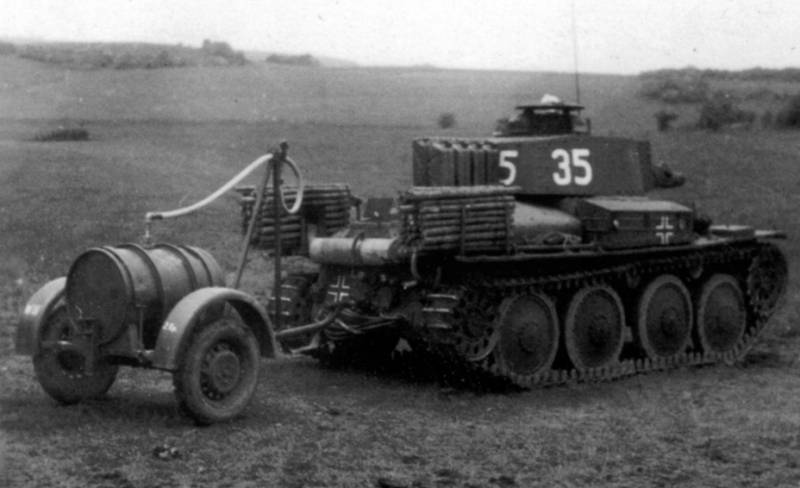
Transporter 37L "Lorraine" with a trailer
The British had their own problems associated with the fact that in the British army the supply of tank units was carried out with the help of cars. And during the fighting in North Africa, one unpleasant thing came to light.
Despite the short range of British tanks, which did not exceed 250-270 km, fuel trucks, and vehicles with other cargoes, often did not keep up with them, which made it difficult to supply. They thought that "it's better to carry everything with you." And if so, then why not create a tank transporter that tanks could carry with them, and in it an additional supply of fuel, fresh water and ammunition. For example, the British did not inspire the French, and they did not want to use a special car with a driver for this. And they developed and built a device called the Rotatrailer.
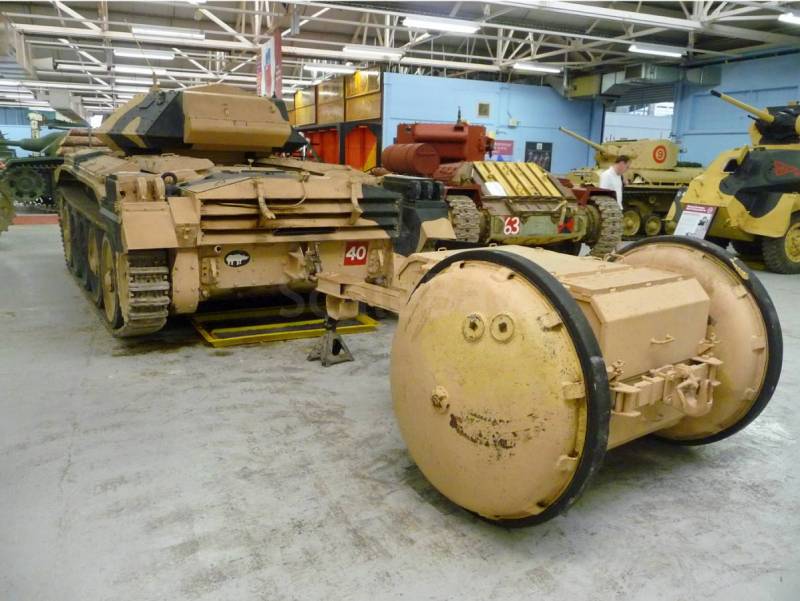
Here it is, "Rotatrailer" in the photo
The Rotatrailer was arranged simply, but in an original way. The wheels served as fuel tanks, which were filled with 550 liters. The body of steel sheets with a thickness of 3,175 mm was divided into two compartments with separate covers. They loaded another ton of cargo. A “drawbar” was attached to it in front for towing, and a hook was provided at the back, which made it possible to assemble a whole “road train”.
The conveyor was tested simultaneously in England, the USA and Canada. The Americans did not like it, but in England they adopted it, the Canadians decided to import them from England. However, when they got to the front in North Africa, it turned out that the Rotatrailer had more shortcomings than advantages, so after the delivery of 200 trailers, the army stopped ordering them. Canada also refused to use them.
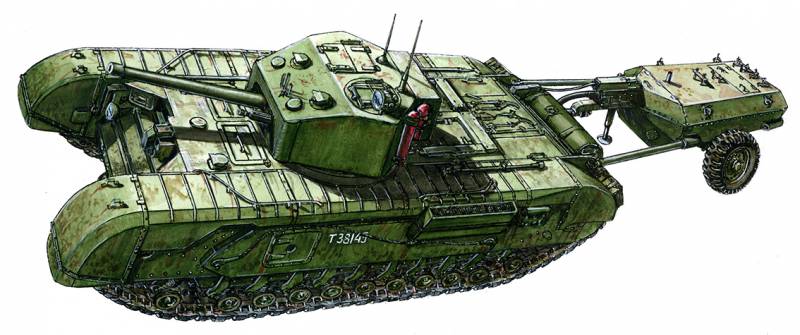
Tank "Churchill Crocodile"
That's just the very idea of the conveyor after this failure did not die at all. The Churchill-crocodile tanks were equipped with an armored trailer for the fire mixture. Then the drag conveyor was attached to the Churchill AVRE tank, which carried fascines on them to fill the German anti-tank ditches with them.

"Churchill" AVRE - fascine transporter
An attempt was made to use the Bran Carrier tankettes with the engine removed from them, which were also supposed to be towed behind the Churchill AVRE tank, as a cargo transporter. It was even easier to equip this tank with the simplest drags and carry various cargoes on it.

"Churchill" AVRE wedge-transporter "Bran Carrier"

British engineering tank "Churchill" AVRE with a blade and drags for transporting various cargoes

Heavy infantry fighting vehicle "Ahzarit" with trailer "Urdan"
After the Second World War, a one-wheeled tank transporter was developed for the Centurion tank and was used with it for some time. There is a trailer "Urdan" and the Israeli heavy infantry fighting vehicle "Ahzarit". That is, the practice of using tank trailers continues, although there are no special innovations in this direction yet.
Drawings by A. Sheps
Information